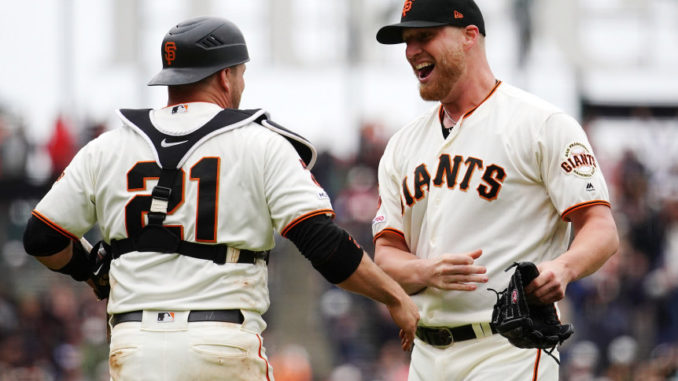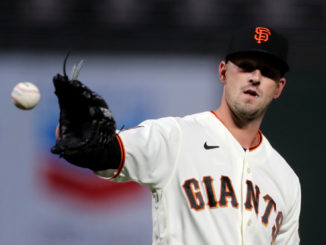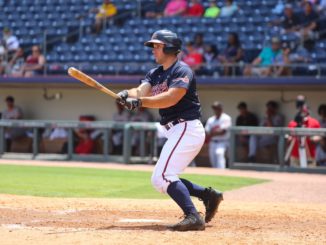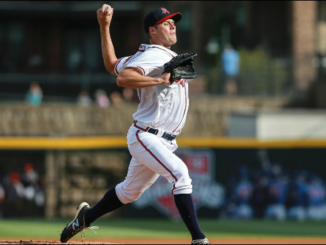The Atlanta Braves have signed LHP Will Smith to a three-year major league contract.

In the second move the Braves have made to address their bullpen in this free agency period, the Braves moved quickly to sign former San Francisco Giant reliever Will Smith to a three-year, $40 million guaranteed contract. The deal will pay Smith $13 million per season in 2020-2022, with a $1 million buyout for 2023, or the Braves could re-up with Smith for an additional $13 million to make the whole potential deal four years and $52 million. In addition, the Braves will forfeit their 2nd-round pick in the 2020 draft and the accompanying draft bonus pool allowance; the pick last year had a slot value of $1.05 million.
The $40 million guarantee is the largest free contract handed out by the Braves since signing outfielder Nick Markakis to a 4-year, $44 million contract before the 2015 season, and the second largest ever given by the Braves to a relief pitcher, just shy of Craig Kimbrel‘s $42 million contract extension in 2014. That was a 4 year deal however, so Smith’s beats Kimbrel’s in terms of average annual value.
Smith was widely seen as the top free agent relief pitcher on the market, with MLB Trade Rumors placing him 13th on their Top 50 Free Agents list and estimating a 3-year, $42 million contract. The slight difference may be accounted for by apparently how quickly Smith wished to move the action.
Will Smith’s agent, Jeff Berry of CAA, effectively used the qualifying offer as leverage, telling interested teams he wanted a deal by today’s deadline or Smith would accept the one-year, $17.8M offer from #SFGiants. In the end, the #Braves bit.
— Ken Rosenthal (@Ken_Rosenthal) November 14, 2019
The deal was announced just 30 minutes before free agents that were given a Qualifying Offer from their former clubs had to either accept or reject them. It was widely speculated that Smith may accept the QO from the Giants, given that relief pitchers don’t often get potentially $17.8 million paydays, and perhaps keeping in mind the fate of Craig Kimbrel last year.
The Player
Will Smith, RP
Age: 30 | Throws: L
2019: 2.76 ERA | 3.23 FIP | 63 G, 0 GS | 65.1 IP | 2.89 BB/9 | 13.22 K/9 | 1.2 fWAR
Career: 3.53 ERA | 3.29 FIP | 359 G, 17 GS | 410.2 IP | 3.27 BB/9 | 10.83 K/9 | 6.9 fWAR
Smith is a graduate of Northgate High School in Newnan, GA and a former Angels 7th-round draft pick in 2008. Smith was traded to the Royals after his A-ball season as part of a package for future Brave Alberto Callaspo, and he made his major league debut in 2012, getting 12 starts with the Royals. It was with Milwaukee however that Smith established himself as a top-flight relief pitcher after a December 2013 trade that sent outfielder Nori Aoki to Kansas City.
In the 2014 season, Smith lead the National League in appearances, seeing 78 games while primarily being used as a LOOGY. The following season went largely the same way, with Smith lowering his ERA by a full run, from 3.70 to 2.70, though Smith also was suspended for 8 games after being caught in a game against the Atlanta Braves using a foreign substance on the ball.
In 2016, the San Francisco Giants were looking for relief help in the stretch run and agreed to trade prospects Phil Bickford and Andrew Susac for Smith. Smith pitched well for the Giants and ended up throwing 2 scoreless innings in the NLCS against the Chicago Cubs, to date his only postseason experience.
Smith sustained damage to his UCL in the spring of 2017 however, and ended up getting the dreaded Tommy John surgery. He returned to major league action by mid-season 2018, and by the end of the season had become the Giants closer, supplanting a carousel of relievers that included Hunter Strickland, Sam Dyson, and future Brave Mark Melancon.
Smith had a terrific 2019 season for the Giants, and was tabbed at the Giants lone All-Star representative and lead all major league pitchers in Win Probability Added, a stat that measures the increased likelihood that a player’s team would win a game based on his performance.
Smith is primarily a four-seam fastball/slider pitcher, with a curveball and change-up mixed in occasionally. The fastball averages around 93 mph and Smith likes to run it up and away from right-handed batters, then change eye level with the slider running in on righties at around 81 mph with near curveball depth. The slider is one of the best in the major leagues. Here Bryce Harper demonstrates.
The Big Picture
This signing represents a substantial change from the way that GM Alex Anthopoulous has started his first two offseasons as the man in charge of acquisitions. The Braves historically have been reluctant to sink too much of the payroll into the bullpen, and for good reason — relievers are notoriously inconsistent year-to-year. Fans don’t have to look farther than last season to see that, when the likes of Arodys Vizcaino, A.J. Minter, Jesse Biddle, Jonny Venters, and Chad Sobotka were, not unreasonably, expected to form a solid unit based on 2018 results.
As it stands, this total projected 2020 salary of the current bullpen (arbitration projections in italics):
Melancon: $14,000,000
Smith: $13,000,000
Greene: $6,500,000
O’Day: $2,250,000
Jackson: $1,900,000
Newcomb: $575,000
Minter: $558,000
Webb: $558,000
Total: $39,341,000
I have previously guesstimated that the Braves payroll would be around $137 million for 2020, so as configured the bullpen would constitute nearly 30% of the payroll. Anthopoulous has surprised me before (most recently with this signing), but it seems unlikely that the Braves would purposely devote that much of their payroll towards relievers.
That leads to some interesting possibilities.
- The Braves payroll for 2020 could actually be significantly higher than $137 million. This is the possibility that would make pretty much everyone happiest. If the payroll were, say, $147 million, then the bullpen percentage is down several percentage points and the front office still has plenty of room to address the line-up, catcher, rotation, and maybe even pick up another reliever.
- The Braves could trade Melancon. The Braves were able to get Melancon because the Giants were looking to shed salary at the deadline and would take a relatively slight prospect haul to do it. The complicating factor here is Melancon’s full no-trade clause (seriously?), which he waived to come to a contender at the deadline. If he were to agree to another trade, it would likewise probably need to be to a contender, and without deadline pressure he could possibly leverage the no-trade clause into financial consideration.
- The Braves could trade or non-tender Greene. If the Braves do want to shed bullpen salary, this would be the quickest way to do so. Greene likely would have some trade value, but even if they couldn’t find a partner, the Braves could simply non-tender him to free agency. Of course that would open up another hole in the bullpen.
At an even higher level is what the loss of the draft pick could indicate. The Braves are still under international signing sanctions, with this current period containing the most onerous of penalties — the Braves have no international bonus pool and cannot sign any international amateur for a bonus over $10,000. The Braves only have the draft to maintain a talent pipeline, so the loss of even a second-round draft pick carries a heavier weight for Atlanta than other teams.
But it’s also possible that the front office and ownership, after their second divisional title but also seeing a division rival win the World Series as a wild card, is ready throw caution the wind and stack the major league roster for 2020. If that’s the case this offseason could be a wilder ride than most people would have considered.
Note: I made no “Fresh Prince” or other Will Smith puns, and am hereby putting my hat in the ring for a Pulitzer Prize.




This year, the Braves have the ability so sign international free agents to the extent that they have only 50% of their normal capacity of money allowed by the league. Last season was the only season that they could not sign free international free agents for $10,000 or less.
The international signing periods start on July 2. They are currently still in the no-bonus pool year. When the new signing season opens on July 2, 2020 they will have the 50% bonus pool that you describe.
Thanks for reading!